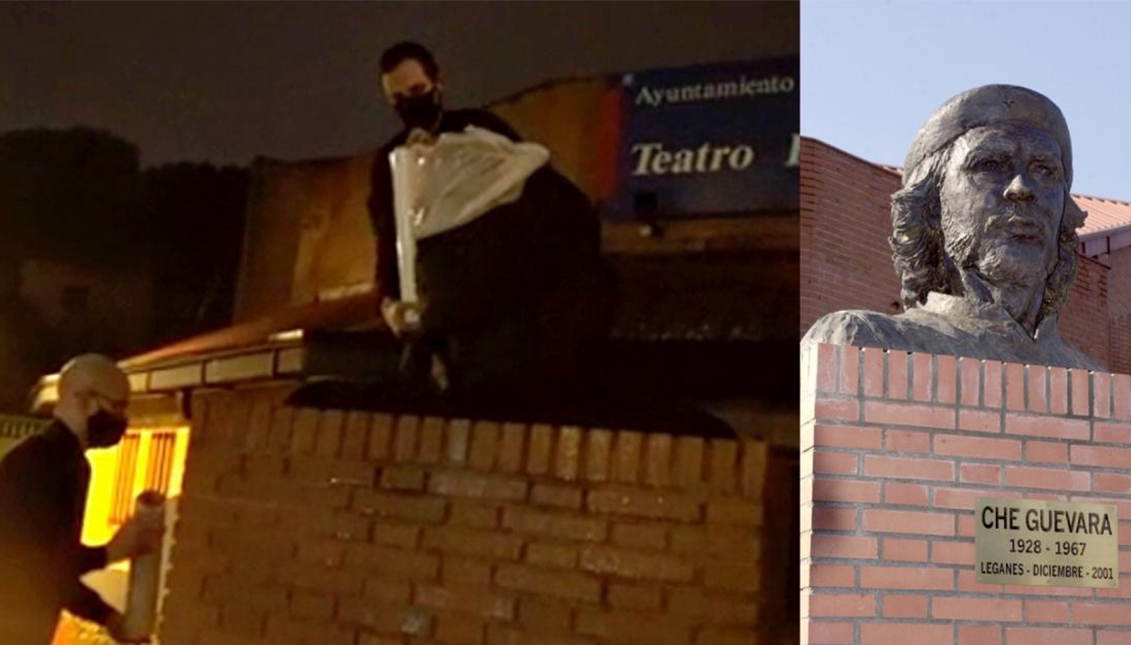
Ernesto Che Guevara, the myth of the good partisan who proved not to be so
The statues of Conquerors and Slavers are not the only ones to be vandalized. Now it's the revolutionaries' turn.
In the middle of October, the city of Leganes, in Madrid (Spain), awoke to a change in its landscape that many of sleepy neighbors didn't notice.
The bust of Argentine guerrilla Ernesto Che Guevara, who together with Fidel Castro made the so-called Cuban Revolution, was covered with tape.
Immediately, three Spanish artists, Omar Jerez, Julia Martinez and Aritz Martin, claimed credit for the feat.
They had done it as part of a political performance, an action they called "criminal whitewashing," which they released with a video on YouTube.
The artists asked themselves: "Is Ernesto Che Guevara the most whitened character in history?"
Beyond an anecdotal protest, the intervention was considered both a political and artistic gesture, and a review was published stating the artists proposed a "critical and direct reflection on the existing distortion around the mythical figure of Che: the construction of the false myth and the dichotomy between the real and the invented."
Among the many obscurities surrounding the figure of Che is his aversion to homosexuals, whom the revolutionary believed to be "sexual perverts" and contrary to the ideals of the "new man," warned one of the artists.
In fact, as they well remember, Guevara was involved in the creation of the first labor camp in the Guanahacabibes peninsula, in 1960, where thousands of homosexuals were later imprisoned and was the predecessor to the Production Assistance Units (UMAP).
The most emblematic Argentinean who has had more T-shirts printed in history was not the only homophobe in a revolution of bearded guerrillas. Fidel Castro also maintained in several interviews the incompatibility of the homosexual with true communism.
RELATED CONTENT
"We have never believed that a homosexual can personify the conditions and requirements of conduct that allow us to consider him a true revolutionary," said the late Cuban leader. "A deviation of that nature clashes with the concept we have of what a militant communist should be."
Although, indeed, homophobia was already in the seed of historic Cuban leaders, such as writer and politician José Martí, who in his work, Nuestra América, identified the "homosexual as an effeminate being incapable of building a nation."
The processes of whitening and construction of myths such as that of Guevara, who became the good and rational fighter for freedom, are inherent to the warlike and divisive narrative that seeks to nourish a common identity through concealment and manipulation. This does not mean that characters like Che did not have a key role or merit in his struggle; however, in a society that takes the part for the whole, the "white" myths are dangerous even for the construction of the communitarian identity that is sought with them.
"One does not have to go very far to witness this exaltation or whitening of the false myth. A bust as a tribute to a murderer, homophobe and racist in the Madrid town of Leganes," concluded the artists in their note.
Spaniards Omar Jerez and Julia Martinez are not new to the art of shaking up society and turning its false myths upside down. They have put themselves at risk on more than one occasion with their performances.
In one of his most famous works, Omar Jerez in Wonderland, the artist walked in blood, carrying an apparent corpse in his arms through the streets of the Basque city of San Sebastian, which was once described as the "epicenter of Basque nationalism," to pay homage to the victims of the terrorist group ETA.
Jerez also experienced a week-long imprisonment of a Spanish prison officer, José Antonio Ortega Lara, who was kidnapped by ETA and lived for more than a year in a tiny basement. He also traveled on the "Beast," (la Bestia) the dangerous and inhumane train that carries migrants from Mexico to the United States, and did not hesitate to criticize the Italian Camorra in the middle of the city of Naples.











LEAVE A COMMENT: